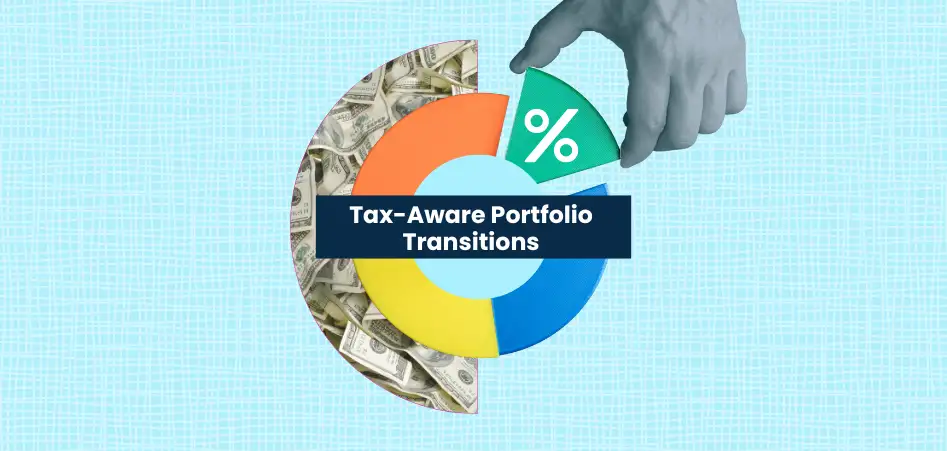Talking to advisors and asset managers about tax loss harvesting, I spend a lot of time discussing tracking error. The benefits of harvesting losses are well documented in academic research, but the increase in tracking error relative to the target strategy is a tradeoff many investors haven’t made before. It requires a different way of thinking about tracking error and uncertainty risk.
To understand tracking error, let’s start with a quick refresher on statistics. Don’t worry — you don’t need to pull out the old college textbook or dust off the CFA materials.
Tracking error is uncertainty
Tracking error measures the variation of a portfolio’s return compared to its target benchmark. Specifically, it is the standard deviation of excess returns measured on a daily basis and then annualized. Higher tracking error means there is a greater risk that the portfolio returns will look different than the benchmark returns.
This visual from Qontigo is a great way to intuitively grasp the risk introduced by increased tracking error.
As an advisor, tracking error represents investment risk and client risk. If performance is materially worse than the stated benchmark, you’ll have to defend your investments in a client meeting and work to keep the client. Even if the underperformance is justifiable, there is the challenge of translating that into terms the client understands.
Morningstar explains the classical view of tracking error succinctly:
“Active fund managers show a large Tracking Error because they seek excess return (alpha) through active positioning versus the benchmark. Passive fund managers aim for a low Tracking Error. Lower Tracking Error means that the fund tends to hew pretty close to the index in terms of its performance. A higher one means that the fund is all over the place and probably doing something that's quite different from the index.”
The rise of passive investing and the ease of using ETFs to build portfolios has led to a singular focus on minimizing tracking error. And, as Morningstar highlights for evaluating index mutual funds and ETFs, that makes sense.
Assuming you are comfortable with the target index and its composition, you will do well picking index strategies optimizing for the lowest cost and tracking error. This approach removes (some) uncertainty by taking exactly what the market gives you. And in a world of standardized model portfolios, this approach works reasonably well.
However, if you are focused on minimizing risk, you may miss opportunities to add value to clients. I could minimize the risk of personal injury by never getting in my car or walking down the street. Unfortunately, I would miss out on meeting new people, driving great back roads, and seeing new places.
In addition, the wealth management industry is moving away from standardization. Investment plans, portfolios, and tax planning are becoming bespoke. Advisors differentiate themselves by delivering advice tailored to meet clients' specific goals. Against this backdrop, tracking error takes on new importance.
Tracking Error is a Tradeoff
Tracking error goes by another name: active risk. I personally prefer the term active risk because it better describes the portfolio manager mindset of balancing risks and rewards.
Index portfolio managers deviate from the benchmark when they lend securities, harvest losses, and trade around index reconstitutions. There is value in those actions, but there is an increased risk the portfolio drifts from its target. Active portfolio managers take risks when they select the companies they believe will outperform the benchmark.
Advisors can take a similar risk-reward approach to evaluating tracking error in their portfolios. Some deviations from the benchmark are intentional, compensated risks. For example, we recently modeled a tax-managed portfolio for an advisor that removed a top ten holding in the S&P 500 because the client had stock grants that would vest over time. Tracking increased from less than 1% to over 2%; however, viewed in the context of the client’s full financial picture, this portfolio brought them closer to their ideal portfolio.
This risk-reward framework can help advisors bring a more nuanced approach to evaluating tracking error. Instead of unilaterally minimizing tracking error, advisors can take on incremental risk when they believe it maximizes value for the client.
In the case of tax loss harvesting, this framework requires thinking about the potential added value of tax alpha compared to the risk of deviating from the benchmark.
Tracking error in tax-managed strategies
Having these tradeoff conversations with advisors, I’ve found it helpful to start with the sources of tracking error in tax-managed accounts. Here are common reasons that a tax-managed portfolio may differ from its intended target:
- Replication: Large ETFs that pool investor assets are able to fully replicate the index they track. Tax-managed accounts may have smaller balances and cannot buy every stock in the index. In addition, there may be times when an advisor doesn’t want to replicate the index fully—for example, clients with concentrated positions elsewhere or values-based screening.
- Wash-sale rule: If a stock is sold at a loss, it cannot be repurchased for 31 days. During this wash-sale window, the portfolio is likely underweight the position relative to the benchmark. Relatedly, proceeds from harvested trades are invested in the portfolio
- Rebalances: Indices go through reconstitutions, and active strategies trade into new names. Timing differences between the tax-managed portfolio and the target strategy can cause deviations in performance.
- Capital gains management: Beyond harvesting losses, tax-managed strategies seek to avoid short-term gains and defer taxes. Depending on the timing of rebalances of target strategies, tax-managed portfolios may hold onto dropped names until they become long-term gains.
Remember that tracking error is a tradeoff — and some level of noise is inevitable. The goal is to know what’s causing it and to consciously balance the risk it creates with the rewards you hope to earn through direct indexing.

Tracking error and tax alpha
Based on our research, tracking error in tax-managed SMAs is expected to be about 1% for index strategies and 2-3% for traditional active strategies. It depends on the specific strategy, account size, and aggressiveness of tax loss harvesting.
So, how can advisors evaluate the tradeoffs between tracking and tax alpha? Here are my three steps:
- Take a long-term historical view of the value of tax loss harvesting. This paper from Chaudhuri is a good place to start. Estimates for tax alpha in published research range from 25 - 200 basis points, but it varies by client type and across market environments.
- Consider the value of tax management to your specific clients. Look at your clients’ tax rates, capital gains profile, amount of taxable assets, contributions, and charitable giving.
- Backtest specific investment strategies and client attributes to get a sense of tracking error, turnover, and tax alpha in recent market environments. Backtests are hypothetical, but they can be a helpful tool for visualizing these tradeoffs.
If you want to really dig in, here are two more resources that can help you think about the tradeoffs of higher tracking error vs. added value.
- CFA Intitute post evaluating whether higher tracking error can lead to higher after-tax returns in different types of ETFs
- AQR whitepaper discussing minimizing unintentional sources of active risk while focusing on value-add risks
If you are interested in backtesting different strategies to see what tracking error may look like for your clients, reach out to me at kyle@quorus.io for a 1:1 consultation.
Disclosures
Investing in securities involves risks, including the risk of loss, including principal. Quorus Inc., is an RIA registered in the States of Connecticut and Pennsylvania. Neither regulator has approved this message.
Certain information contained in here has been obtained from third-party sources. While taken from sources believed to be reliable, Quorus has not independently verified such information and makes no representations about the accuracy of the information or its appropriateness for a given situation.
This content is provided for informational purposes only, as it was prepared without regard to any specific objectives, or financial circumstances, and should not be relied upon as legal, business, investment, or tax advice. References to any securities are for illustrative purposes only and do not constitute an investment recommendation or offer to provide investment advisory services. Furthermore, this content is not intended as a recommendation to purchase or sell any security and performance of certain hypothetical scenarios described herein is not necessarily indicative of actual results. Any investments referred to, or described are not representative of all investments in strategies managed by Quorus, and there can be no assurance that the investments will be profitable or that other investments made in the future will have similar characteristics or results.
Charts and graphs provided within are solely for informational purposes and should not be relied upon when making investment decisions. Past performance is not indicative of future results. The content speaks only as of the date indicated. Any projections, estimates, forecasts, targets, prospects, and/or opinions expressed in these materials are subject to change without notice and may differ or be contrary to opinions expressed by others.




.webp)
